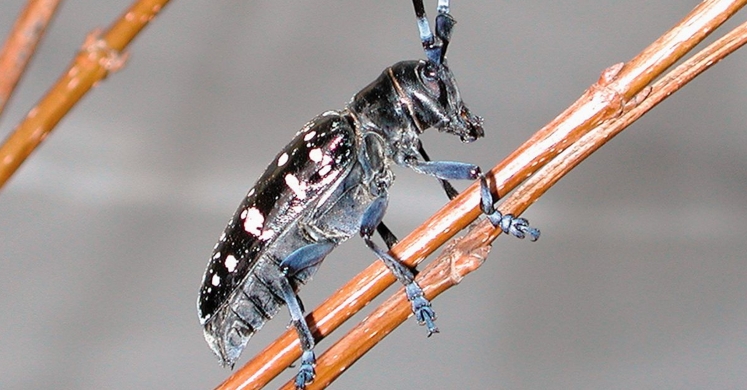Blog

#bioPGH Blog: Asian Longhorned Beetle
 A resource of Biophilia: Pittsburgh, #bioPGH is a weekly blog and social media series that aims to encourage both children and adults to reconnect with nature and enjoy what each of our distinctive seasons has to offer. From the best times to plant seasonal flora and enjoy their peak blooms, to astronomical events and creatures to keep an eye and ear out for, Phipps will keep you in the know with what’s going on in our environment!
A resource of Biophilia: Pittsburgh, #bioPGH is a weekly blog and social media series that aims to encourage both children and adults to reconnect with nature and enjoy what each of our distinctive seasons has to offer. From the best times to plant seasonal flora and enjoy their peak blooms, to astronomical events and creatures to keep an eye and ear out for, Phipps will keep you in the know with what’s going on in our environment!
What’s black and blue and wants to eat several trees in your backyard? The Asian longhorned beetle! Native to Asia, this tree pest immigrated to Brooklyn, NY in 1996 and has since found its way to Massachusetts, New York and Ohio, but it threatens trees throughout Pennsylvania and the Northeast. The Asian longhorned beetle (Anoplophora glabripennis) prefers maple, elm, horse chestnut, ash, birch, poplar and willow. With such a wide host range, the beetle may detrimentally affect the maple syrup, lumber, plant nursery and tourism industries. Even though the beetle hasn’t yet been found in Pennsylvania, our state’s trees and industries are at risk of infestation, and August is the best time to find adults. Beetle larvae burrow into the tree trunk and branches, interfering with the vascular system that carries water and nutrients throughout the tree. When these pathways are cut off, the tree will die.
What makes the Asian longhorned beetle an invasive species? First, let’s establish what an invasive species is. According to Executive Order EO13112, an invasive species is “an alien (or non-native) species whose introduction does, or is likely to cause economic or environmental harm or harm to human health." While there are many non-native species in the United States, only a small proportion are actually considered invasive. However, with increased global travel and shipping, the opportunity for insects, plants and animals to move around the world, and potentially become invasive, is higher than ever before.
The Asian longhorned beetle is glossy black and smooth, about 0.75 to 1.5 inches long. It has irregular white spots on its back, long black antennae banded with blue or white stripes, and black and blue legs. It is often confused with the Whitespotted Sawyer (Monochamus scutellatus), a native boring beetle that feeds on conifers, but is not a threat. You can compare the two species here.
Connecting to the Outdoors Tip: August is Asian longhorned beetle awareness month! This is the time of year you’re most likely to find adults, as they’re now emerging from infested trees. Look for round, dime-sized exit holes on tree trunks; these are evidence that adult beetles are present. In the summer and fall, females create oval or round divots in the bark where they lay eggs. These eggs hatch, and the pupae will chew their way into the tree to grow. In the summer, look for oozing sap, particularly in maple trees, evidence of larvae feeding inside the tree. Coarse sawdust can be found at the base of trees or in the crooks of branches of infested trees. You can find images of these clues here. Monitor trees on your property for signs of the beetle, and if you do suspect beetle activity, use the appropriate authorities here or here.
There are activities for little ones, too: Plantheroes.org is a site with fun, educational activities to help children become stewards of their environment and learn about invasive pests and pathogens. More children’s activities are available from the USDA. One important task everyone can do to reduce the spread of the Asian longhorned beetle (and other tree pests) is to avoid moving firewood.
Continue the Conversation: Share your nature discoveries with our community by posting to Twitter and Instagram with hashtag #bioPGH, and R.S.V.P. to attend our next Biophilia: Pittsburgh meeting.
Resources:
Executive Order 13112 | Invasive Species
PlantHeroes.org Field Guide: Asian Longhorned Beetle
Asian Longhorned Beetle versus Whitespotted Sawyer
USDA APHIS | Asian Longhorned Beetle
USDA Asian Longhorned Beetle | Signs to Look For
PA DCNR | Reporting Asian Longhorned Beetle
National Plant Board | Reporting Asian Longhorned Beetle
Plant Heroes
USDA | Educational Activities
Hungry Pests | Asian Longhorned Beetle FAQs
Photos © P.S. Meng, K. Hoover, M.A. Keena; Kyle Ramirez (CC-BY 3.0)

